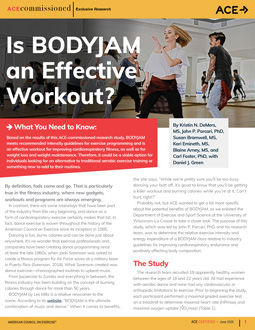
By Kristin N. DeMers, MS, John P. Porcari, PhD, Susan Bramwell, MS, Kari Emineth, MS, Blaine Arney, MS, and Carl Foster, PhD, with Daniel J. Green
What You Need to Know
Based on the results of this ACE-commissioned research study, BODYJAM meets recommended intensity guidelines for exercise programming and is an effective workout for improving cardiorespiratory fitness, as well as for weight loss and weight maintenance. Therefore, it could be a viable option for individuals looking for an alternative to traditional aerobic exercise training or something new to add to their routines.
By definition, fads come and go. That is particularly true in the fitness industry, where new gadgets, workouts and programs are always emerging.
In contrast, there are some mainstays that have been part of the industry from the very beginning, and dance as a form of cardiorespiratory exercise certainly makes that list. In fact, dance exercise is woven throughout the history of the American Council on Exercise since its inception in 1985.
Dancing is fun, burns calories and can be done just about anywhere. It’s no wonder that exercise professionals and companies have been creating dance programming since at least the late 1960s, when Jacki Sorensen was asked to create a fitness program for Air Force wives at a military base in Puerto Rico (Sorensen, 2018). What Sorensen created was dance exercise—choreographed routines to upbeat music.
From Jazzercise to Zumba and everything in between, the fitness industry has been building on the concept of burning calories through dance for more than 50 years.
BODYJAM by Les Mills is a relative newcomer to the scene. According to its website, “BODYJAM is the ultimate combination of music and dance.” When it comes to benefits, the site says, “While we’re pretty sure you’ll be too busy dancing your butt off, it’s good to know that you’ll be getting a killer workout and burning calories while you’re at it. Can’t hurt, right?”
Probably not, but ACE wanted to get a bit more specific about the potential benefits of BODYJAM, so we enlisted the Department of Exercise and Sport Science at the University of Wisconsin–La Crosse to take a closer look. The purpose of this study, which was led by John P. Porcari, PhD, and his research team, was to determine the relative exercise intensity and energy expenditure of a BODYJAM class relative to industry guidelines for improving cardiorespiratory endurance and positively affecting body composition.
The Study
The research team recruited 19 apparently healthy women between the ages of 18 and 22 years old. All had experience with aerobic dance and none had any cardiovascular or orthopedic limitations to exercise. Prior to beginning the study, each participant performed a maximal graded exercise test on a treadmill to determine maximal heart rate (HRmax) and maximal oxygen uptake (VO2max) (Table 1).
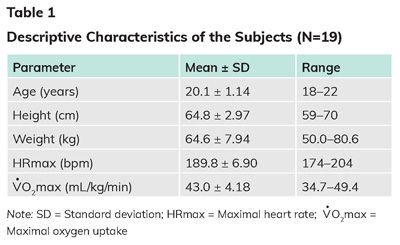
Each participant then practiced the BODYJAM session at least three times. Once the research team deemed each participant proficient, the participant completed a 55-minute session by following along to a recorded BODYJAM workout video. Each session included at least four participants exercising together to achieve the “group effect” that Les Mills—the company behind BODYJAM—is known for in their classes.
After a five-minute warm-up, the video introduced various dance combinations, during what is known as the “rehearsal phase.” The combinations began with the basic steps. Layering was then incorporated by starting with a base move and then adding various upper- and lower-body movements. After all of the dance combinations were taught, the class performed a double-time “bust out performance.” The workout ended with a five-minute cool-down.
Each participant’s heart rate (HR) was recorded continuously throughout the workout and a rating of perceived exertion (RPE) was taken after the warm-up, every three to five minutes during the “bust out performance,” and after the cool-down, using the 6-to-20 scale.
The heart rates at each minute of the BODYJAM session were used to calculate oxygen uptake (VO2), and energy expenditure was calculated from that data.
The Results
Heart Rate and Maximal Heart Rate
The HR and %HRmax responses to the 55-minute BODYJAM session are presented in Figures 1 and 2, respectively. The average HR was 139 ± 6.59 bpm, while the average %HRmax was 73 ± 3.5%.
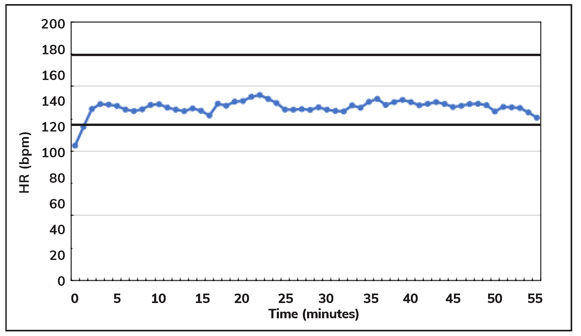
Figure 1. Average minute-by-minute HR responses to the BODYJAM session
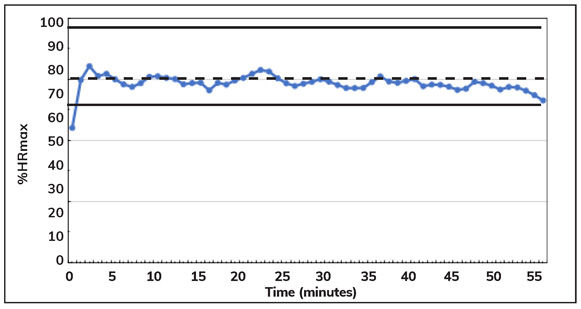
Figure 2. Minute-by-minute relative HR responses (%HRmax) to the BODYJAM session.
Industry guidelines recommend that an individual should exercise at 64 to 95% of HRmax to improve cardiorespiratory endurance [American College of Sports Medicine (ACSM), 2018], which is represented by the boxed area in Figure 2. The separation between moderate and vigorous intensity ranges is represented by the dotted line.
Maximal Oxygen Uptake
Average predicted VO2 and %VO2max responses during the BODYJAM session are presented in Figures 3 and 4, respectively. The average predicted VO2 was 22.3 ± 2.81 mL/kg/min, while the average %VO2max was 52 ± 6.6%.
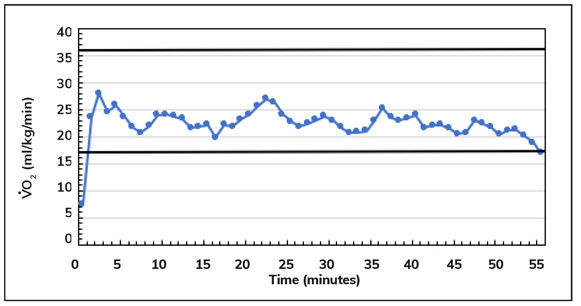
Figure 3. Average minute-by-minute VO2 responses to the BODYJAM session
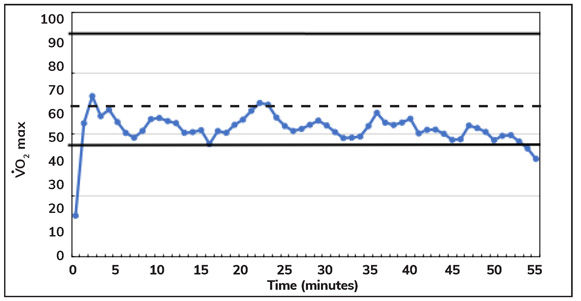
Figure 4. Minute-by-minute relative VO2 responses (%VO2max) to the BODYJAM session
Established guidelines recommend exercising at 46 to 90% of VO2max (ACSM, 2018), which is represented by the boxed area in Figure 4. The separation between moderate and vigorous intensity ranges within the guidelines is represented by the dotted line.
Energy Expenditure
The average energy expenditure during the BODYJAM session was 7.1 ± 1.57 kcal/min and the number of calories expended during the 55-minute workout averaged 393 ± 86.4 kcal.
Rating of Perceived Exertion
Average RPE values at the end of each segment throughout the BODYJAM session are presented in Figure 5. The average RPE for the entire BODYJAM class was 11.1 ± 1.36. Excluding the warm-up and cool-down, the average for the workout portion of the class was 11.5 ± 1.91.
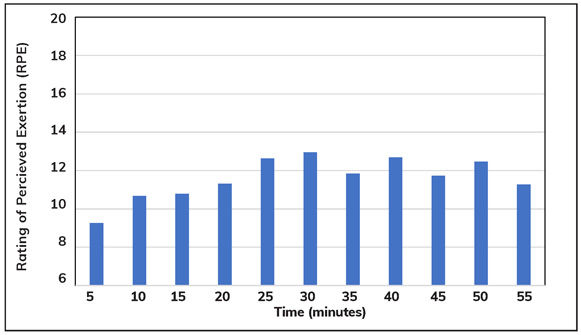
Figure 5. Rating of perceived exertion (RPE) responses to the BODYJAM session
The Bottom Line
The purpose of this study was to determine the relative exercise intensity and energy expenditure of a BODYJAM class relative to accepted guidelines for improving cardiorespiratory endurance and positively affecting body composition.
To improve cardiorespiratory endurance, ACSM (2018) recommends that an individual exercise at a moderate-to-vigorous intensity of 64 to 95% of HRmax or 46 to 90% of VO2max. The current study found that participants were exercising at an average of 73% of HRmax and 52% of VO2max, which fall within the moderate-intensity range (i.e., 64 to 76% of HRmax and 46 to 63% of VO2max).
In terms of energy expenditure, it is recommended that individuals expend 1,200 to 2,000 kcal per week (240 to 400 kcal per exercise session) to positively affect body composition (Donnelly et al., 2009). The participants in this study expended an average of 393 kcal during the 55-minute class. This indicates that BODYJAM could be used as an effective workout for weight management.
In summary, BODYJAM meets recommended intensity guidelines for exercise programming and is an effective workout for improving cardiorespiratory fitness, as well as for weight loss and weight maintenance. Therefore, it could be a viable option for individuals looking for an alternative to traditional aerobic exercise training or something new to add to their routines.
This study, which was commissioned by the American Council on Exercise, was first published in the peer-reviewed International Journal of Research in Exercise Physiology.
References
American College of Sports Medicine (2018). ACSM’s Guidelines for Exercise Testing and Prescription (10th ed.). Philadelphia: Wolters Kluwer.
Donnelly, J. et al. (2009). Appropriate physical activity intervention strategies for weight loss and prevention of weight regain for adults. Medicine & Science in Sports & Exercise, 41, 459–471.
Sorensen, J. (2018). Team Sorensen Bios.





 by
by 

